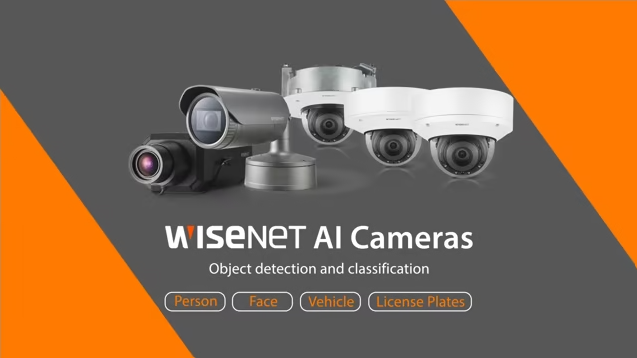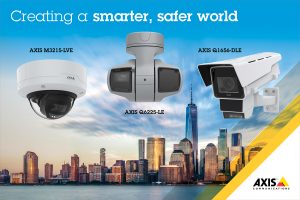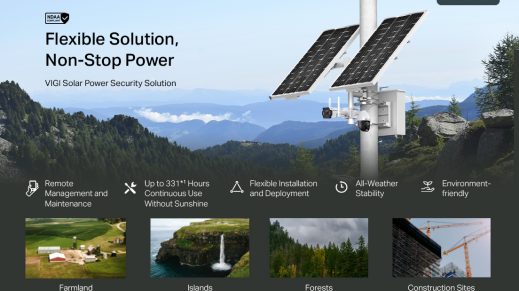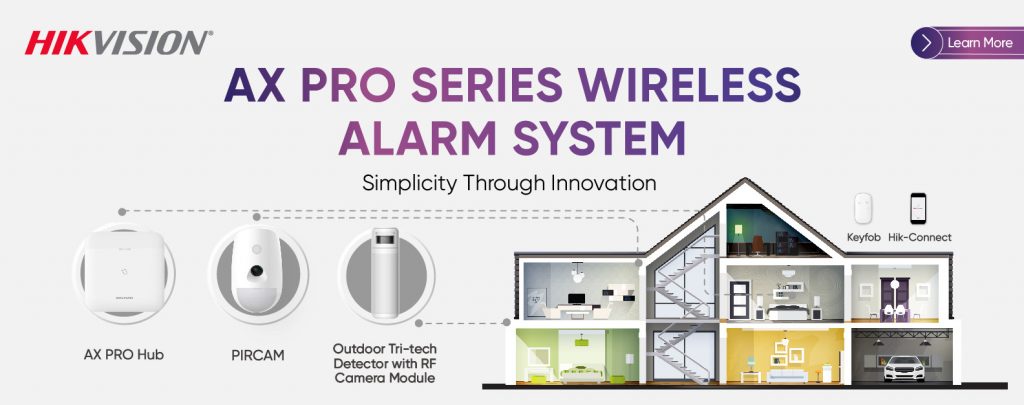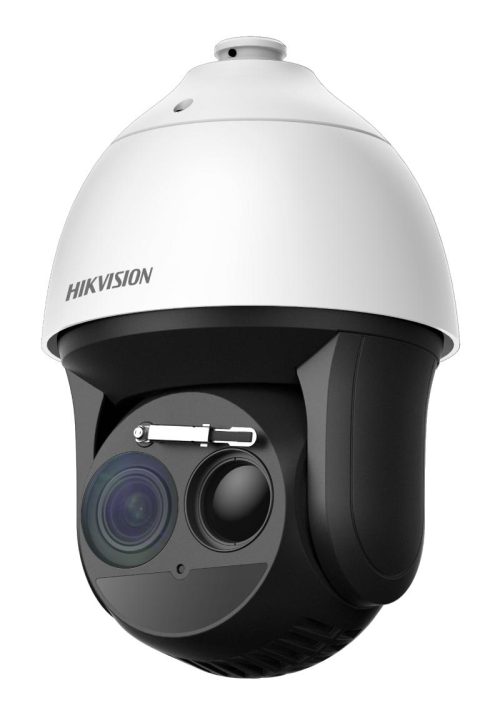This Anti-corrosion Thermal & Optical Bi-spectrum Network Speed Dome integrates thermal VOx imaging with a high-resolution optical channel for versatile monitoring. Built to withstand harsh environments, it offers intelligent detection capabilities—ideal for securing perimeters in industrial, infrastructure, and critical outdoor settings.
Thermal Module
-
VOx Uncooled Focal Plane Array
-
640 × 512 resolution; 17 µm pixel pitch; NETD ≤ 40 mK (at 25 °C, F# = 1.1)
-
50 mm fixed thermal lens; field of view ~12.4°×9.9°; athermalized focus
-
Digital zoom ×2, ×4, ×8
-
Advanced image processing: linear histogram, self-adaptive AGC, DDE, 3D DNR
-
Includes a high-quality detector with 10-year guarantee
Optical Module
-
1/1.8″ Progressive-scan CMOS sensor; up to 4 MP resolution
-
Minimum illumination: ~0.005 Lux (Colour), ~0.001 Lux (B/W) at F1.3, AGC ON
-
Motorized 6–240 mm zoom lens (40× optical), with auto/semi-manual focus
-
Field of view from 56.6°×33.7° to approximately 1.8°×1.0°
-
Digital zoom ×2, ×4, ×8, ×16, plus 120 dB WDR and optical defog functions
-
Picture-in-picture overlay to combine thermal and optical views
PTZ & Movement
-
Full 360° continuous pan and –20° to +90° tilt with auto-flip
-
Pan/tilt speeds configurable up to ~200°/s (preset speed)
-
Advanced presets and scanning modes: 300 total presets (273 configurable), 8 patrol tour patterns, 4 pattern scans (over 10 minutes each), panorama, scheduled tasks, park actions
Smart Functions
-
Intelligent perimeter protection: VCA rules include line crossing, intrusion, region entrance/exit—supporting multiple scenes and up to 8 rules per scene
-
Temperature anomaly alarms and dynamic fire detection assist early warning for fire prevention
-
Smoke detection algorithms enhance threat response capability
Video Compression & Network
-
Thermal channel supports up to 50 fps recording in multiple resolutions; optical stream supports 25/30 fps depending on region
-
Supports H.265+, H.265, H.264+, H.264 codecs
-
Advanced networking: IPv4/IPv6, HTTPS, 802.1x, QoS, RTSP, SMTP, FTP, DNS/DHCP, NTP, ONVIF, and Hikvision proprietary protocols
-
Supports microSD, NAS, and ANR for on-board or networked storage
Compliance & Environmental
-
IP66-rated for water/dust protection
-
Anti-corrosion coating for harsh outdoor environments
-
Designed to withstand high levels of environmental wear—ideal for coastal, industrial, or exposed installations
Use Cases
-
Industrial perimeter security: Ideal for installations such as ports, power plants, and refineries where environmental resistance and long-range thermal/optical detection are critical.
-
Fire-prone zones: Integrated fire and temperature anomaly detection help identify fire early in remote areas, reducing response times.
-
Perimeter patrol and tracking: Wide zoom range and PTZ features allow automatic scanning and tracking of threats—combined with thermal imaging to operate effectively day or night.
FAQs
Q: How far can the DS-2TD4167-50/WY detect people and vehicles?
A: With its 50 mm thermal lens, it can detect human-sized heat signatures at well over 1 km and vehicles at several kilometres, depending on conditions.
Q: Is it suitable for coastal or corrosive environments?
A: Yes. It features an anti-corrosion coating designed for marine, coastal, and harsh industrial areas.
Q: Can it detect fires?
A: Yes. It includes temperature anomaly alarms and dynamic fire detection, allowing it to detect hotspots and smoke before flames are visible.
Q: Does it have PTZ movement?
A: Yes. It offers full 360° continuous pan and –20° to +90° tilt, with up to 200°/s preset pan speed.
Q: Can it operate at night without any lighting?
A: Yes. The thermal channel works entirely without visible light, and the optical channel benefits from low-light sensitivity for better detail in dim environments.
Q: Can I use both optical and thermal views at the same time?
A: Yes. It supports picture-in-picture overlay to see both thermal and optical feeds simultaneously.
Usability Comparison – DS-2TD4167-50/WY vs HM-TD95C8-150ZE4FL/W
| Feature / Use Case |
DS-2TD4167-50/WY |
HM-TD95C8-150ZE4FL/W |
| Thermal Lens |
Fixed 50 mm (FOV ~12.4° × 9.9°) – wide enough for general thermal monitoring but not ultra-long-range zoom |
Motorized 30–150 mm – can zoom thermal in/out for detailed long-range detection |
| Optical Zoom |
40× optical (6–240 mm) – good for medium to long range |
80× optical (10–800 mm) – extreme long-range detail capture |
| Environmental Protection |
IP66 + anti-corrosion coating – built for marine/coastal/industrial |
NEMA-4X anti-corrosion – very high durability for corrosive and extreme conditions |
| Detection Range |
Excellent for 1–2 km detection but fixed thermal lens limits flexibility |
Superior long-range flexibility; can adjust zoom to match detection task |
| Best Use Case |
Fixed patrol patterns, critical infrastructure near coastal or corrosive zones, industrial perimeter defence |
Large-scale farms, borders, or facilities where patrol requires changing zoom levels and extreme long-range identification |
| Weight/Size |
Smaller, lighter – easier to install on medium poles or masts |
Larger and heavier – typically pole-mounted in fixed PTZ housings with reinforced support |
| Cost/Complexity |
Typically lower cost and simpler to deploy/configure |
Higher cost, more complex setup, but much more capable at distance |
——————
Case Study: Patrolling a 1 km Border with the DS-2TD4167-50/WY
Site Overview
Deployment Strategy
1. Camera Positioning
-
Mount the DS-2TD4167-50/WY on a 15 m high mast at or near the midpoint of the 1 km fence line.
-
Height is crucial — the extra elevation increases visible range for both optical and thermal channels and improves line-of-sight over small terrain undulations.
2. Patrol Setup
-
Thermal Channel:
-
Even though it can’t zoom, it can pan and tilt.
-
Divide the 1 km border into 6–8 overlapping thermal view segments (e.g., 125–170 m sections) using PTZ presets.
-
Each preset points the fixed thermal view at a slightly different angle, overlapping the previous segment for coverage.
-
Optical Channel:
-
Linked to thermal view but with 40× zoom for detail.
-
When thermal detects heat in a preset sector, the PTZ system can stop patrol and optical camera will zoom to that exact location for ID/confirmation.
3. Intelligent Rules
-
Configure line-crossing rules parallel to the fence line in each thermal preset sector.
-
Enable human/vehicle classification to cut false alerts from livestock or wind-blown vegetation.
-
Set fire/smoke detection on each preset sector to provide early warning for bushfires or smouldering equipment.
4. Patrol Timing
5. Integration
-
Connect to an NVR with thermal event bookmarking, so all detections are searchable by alarm type.
-
Optional: integrate with sirens or floodlights along the fence for deterrence when alarms trigger.
Operational Example
-
Patrol Start: Camera begins at Preset 1 (north end of fence), slowly panning thermal view down the line in pre-set jumps.
-
Detection Event: At Preset 4, thermal detects a warm moving shape (human) approaching fence at 600 m from north end.
-
Auto-Response:
-
Patrol halts.
-
Optical zoom instantly moves to 20×–30× for detailed colour view of person.
-
Snapshot sent to owner’s phone with thermal and optical overlay.
-
Optional deterrent: on-board speaker plays a pre-recorded warning.
-
Post-Event: Once alarm clears, patrol resumes at the next preset in sequence.
Key Takeaways for This Model
-
Thermal’s fixed FOV means you patrol by moving the camera, not by zooming thermal.
-
Optical zoom is used only when you need detail after detection.
-
The design excels when you can give it elevation and clear sight lines — the fixed thermal lens still covers significant distances (1–2 km detection) if mounted high enough.











